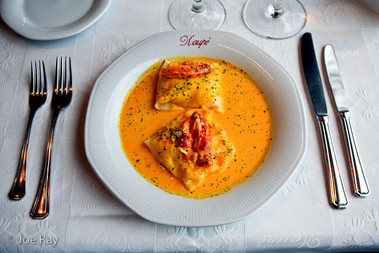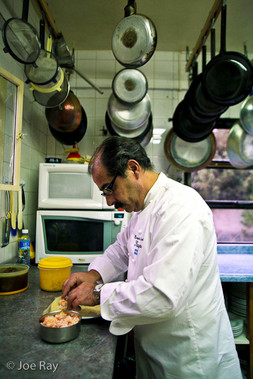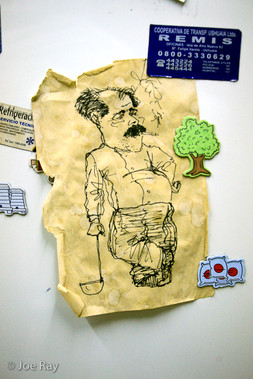Ernesto Vivian - Cooking like it was the end of the world
October 29, 2007 - ASAP / Associated Press

USHUAIA, Argentina
Growing up in New England, one of my favorite food experiences was eating oysters with my dad in Boston’s Faneuil Hall Marketplace. He’d wait for an opportune moment when my mother and sister were shopping, grab my arm and we’d scoot over to the raw bar, promising the ladies we’d be back soon.
Dad would order a cheap draft beer and half a dozen beauties that were shucked under our noses, and I’d watch it all from the barstool, fascinated by the spectacle that, in retrospect, was simply about doing it right, over and over again.
It would drive most chefs crazy, but here in Ushuaia, the end-of-the-world city that dangles off the bottom of South America like an earring, doing the same thing over and over again is a big enough challenge to keep Ernesto Vivian satisfied.
 Ernesto Vivian, the seafood chef at the end of the world.(AP/Joe Ray)
Ernesto Vivian, the seafood chef at the end of the world.(AP/Joe Ray)“It’s a big problem to be a good chef in Ushuaia. Sometimes, it takes all morning to find 10 good tomatoes,” says Vivian, 52, who gestures out the window at the Beagle Channel and the snow-capped peaks that surround the city.
Although spring has technically sprung on this southern side of the equator, the snow is still flying, often pushed horizontally by the wind. It’s hard to imagine how far any tomato, let alone a good one, would have to travel to get here.
His work pays off. He’s won national and international culinary awards, including the 2005 Academia Argentina de GastronomÃa prize for the country’s best restaurant, which is no mean feat considering he lives in what most would consider a culinarily deprived area. Running the restaurant, Kaupé, with his wife Tessy and son Santiago, theirs is one of the few places in town that’s consistently full before the summer tourist season officially begins.
BOILED AT THE SOURCE
Vivian is a peculiar man. He wears trendy glasses over a floppy moustache that would make a walrus proud, and though this is the country of the grilled steak as big as your head, he prefers to cook seafood. You also tend to have all or none of his attention—but if you’ve got it, he talks about food with a combination of love, philosophy and sense of purpose that seems innate in some of cooking’s greatest minds.
To understand why the chef at the end of the world broke the mold that holds 99 percent of the chefs in his country, it’s best to concentrate on his connection to what lurks in the deep, frigid water below town. Vivian and his restaurant are as close to the source as you can get to his specialties, like giant Antarctic king crab and Antarctic scallops.
 A caricature of chef Ernesto Vivian on the refrigerator of Kaupe.(AP/Joe Ray)
A caricature of chef Ernesto Vivian on the refrigerator of Kaupe.(AP/Joe Ray)A far cry from the carb-flavored crab on my plate a few days prior, Vivian’s is another story. His version arrives adorned with only a lemon wedge, and it tastes nothing like bread. It’s served cool, has a slightly firm texture from living in the Arctic depths, and has a delicate flavor that needs only a drop of lemon juice. At this point, I figure the guy’s got a top-secret recipe from God.
“We don’t boil the crab ourselves,” he says, apparently admitting culinary blasphemy while mysteriously pointing toward the sink.
“You need to boil them while they’re alive,” he explains. “I’d rather my fisherman does it. Plus, he boils them in sea water,” which, as I slowly warm to the idea, sounds a lot more authentic than the water from his sink.
Logistically, it makes sense, too. Unlike a relatively compact New England lobster, live king crab has a “wingspan” of a couple of feet. Storing the quantity Vivian needs alive before cooking them to order would require more space than his tiny kitchen allows. Plus, with the beds where Vivian’s fisherman pulls them from the sea a short 23 nautical miles away, they don’t need to be frozen.
___
SIMPLICITY IS KING
Despite menu options that say otherwise, Vivian insists that first tasting his undecorated version is the only way to understand the king crab.
“People come and ask for the King Crab Kaupé,” he says, referring to his thick, chowder-like concoction made with crab and spinach and his king crab crêpes with saffron sauce, “but I ask if they’ve tried the real thing first.”
This sort of product-first simplicity flows through his tasting menu: he lightly marinates Antarctic scallops and tops them with a finely diced onion that’s been marinated separately until it releases a sweet flavor. He also makes a mean tenderloin steak that’s simply seared in a skillet and topped with a cream sauce. Cooking the latter at a slow point toward the end of the evening, he seems to pause to ponder its beauty.
It’s a “Wax on, wax off” purist approach that would confound other chefs in his league, but here at the end of the world, it works.
“Young chefs try to imitate El Bulli,” he says, referring to the famous restaurant outside of Barcelona where superstar chef Ferran Adria creates dishes that smear the line between science and cuisine. “That’s stupid ... There’s only one Dali in the world.”
Taking nothing away from his top-notch colleagues around the world who create dishes with sums greater than their parts, it’s refreshing to meet a chef content to leave a good thing alone, doing it right, over and over again.
“If you eat something that’s the best food of your life,” says Vivian, “you never forget it.”
I should bring dad here.
___
Joe Ray is a Paris-based food and travel writer and photographer currently researching the food and culture of Patagonia. He can be reached via his Web site, www.joe-ray.com.